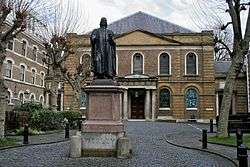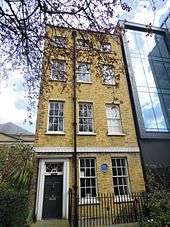Wesley's Chapel
| Wesley's Chapel | |
|---|---|
| Wesley's Chapel and Leysian Mission | |
 Wesley's Chapel | |
| Country | United Kingdom |
| Denomination | Methodist Church of Great Britain |
| Website |
www |
| History | |
| Founder(s) | John Wesley |
| Architecture | |
| Architect(s) | George Dance the Younger |
| Style | Georgian architecture |
| Administration | |
| Division | Wesley's Chapel Circuit |
| Clergy | |
| Minister(s) | Rev. Leslie Griffiths |
Coordinates: 51°31′25″N 0°5′13″W / 51.52361°N 0.08694°W
Wesley's Chapel is a Methodist church in London that was built by John Wesley, the founder of the Methodist movement. It is now a place of worship and visitor attraction, incorporating the Museum of Methodism in its crypt and John Wesley's House next to the chapel.
The chapel opened in 1778 to replace John Wesley's earlier London chapel, the Foundery,[1] where he first preached on 11 November 1739.[2] In 1776 Wesley applied to the City of London for a site to build his new chapel and was granted an area of land on City Road. After raising funds the foundation stone for the chapel was laid on 21 April 1777. The architect was George Dance the Younger, surveyor to the City of London.
Along with the associated Leysian Mission, Wesley's Chapel is a circuit of the London District of the Methodist Church. The chapel has an average Sunday service attendance of 439.[3]
Architecture and internal features

The building has Grade I listed status and is a fine example of Georgian architecture[4] although it has been altered and improved since it was built. In 1864 the gallery was modernised, its front lowered and raked seating installed. The original pillars supporting it were ships' masts donated by King George III but in 1891 they were replaced by French jasper pillars donated from Methodist churches overseas.[1] Stained glass is a later addition. An organ was installed in 1882 and the present organ in 1891. It was electrified in 1905 and in 1938 its pipes were moved to their present position at the rear of the gallery.[5] The communion rail was a gift from former Prime Minister Margaret Thatcher,[6] who was married in the chapel in 1951.[7]
The site

The chapel is set within a cobbled courtyard off City Road, with the chapel at the furthest end and Wesley's house on the right. The house is a well-preserved example of a middle-class eighteenth-century home. It is Grade I listed, and was Wesley's residence for the last eleven years of his life. He is commemorated by a blue plaque on the City Road frontage.
Wesley died on 2 March 1791. His tomb is in the garden at the rear of the chapel alongside the graves of six of his preachers, and those of his sister Martha Hall and his doctor and biographer, Dr John Whitehead.[8] A statue of Wesley with the inscription "the world is my parish" stands at the entrance to the courtyard.
The site also houses one of the few surviving examples of a gentleman's convenience built by the sanitary engineer Thomas Crapper in 1891, and restored in 1972.
John Wesley's House

John Wesley's House was built in 1779 at the same time as the chapel.[9] This building is a rare example of an early Georgian Townhouse and is a Grade I listed building. Built by Wesley and designed by George Dance the younger (who was at that time the surveyor of the City of London). Wesley lived in the house for the last twelve years of his life and died lying in bed in his bedroom. The house was also used to house traveling preachers and their families as well as small group of servants. The house continued to be used for traveling preachers after Wesley's death until it was turned into a museum in the 1900s.
 John Wesley Blue Badge
John Wesley Blue Badge John Wesley's House- Study
John Wesley's House- Study John Wesley's House- Kitchen
John Wesley's House- Kitchen
In the Dining Room his Chamber Horse is set up which he used for exercise and his electric machine is on display in the study which was used to cure illnesses.
 John Wesley's Electric Machine
John Wesley's Electric Machine John Wesley's Chamber Horse
John Wesley's Chamber Horse
At the front of the house is a small Physic Garden which contains herbs mentioned in Wesley's book, The Primitive Physic. It details ways in which common people could cure themselves using natural medicines as they couldn't afford a doctor. Wesley set up the first free dispensary in London giving out medical advice and remedies at his Foundery chapel. John Wesley's Physic Garden.jpg|thumb|John Wesley's Physic Garden
The house is a rare example of a Georgian London townhouse and is still open today to visitors for free private tours. The house is dressed with period furniture which shows what it would have been like when Wesley lived and died there, although the house would have mostly been painted in French Grey rather than fancy wallpaper.
Museum of Methodism

The Museum of Methodism, housed in the chapel's crypt, contains artifacts and relics relating to Methodism, including several of Wesley's speeches and essays on theology.[10] The museum was created in 1978 and was recently refurbished in 2014, with the last case being installed in early 2016 thanks to a generous donations.
 John Wesley's Death Mask
John Wesley's Death Mask John Wesley Ship
John Wesley Ship John Wesley Ceramics
John Wesley Ceramics African Gourd in Museum of Methodism
African Gourd in Museum of Methodism Fijian War Club in Museum of Methodism
Fijian War Club in Museum of Methodism Chinese Ornament in Museum of Methodism
Chinese Ornament in Museum of Methodism
The Leysian Mission
The Leys School was opened in Cambridge in 1875, two years after non-Anglicans were admitted to the universities of Oxford and Cambridge. It was intended to be "the Methodist Eton". Dr William Fiddian Moulton, a biblical scholar and church leader, was its first headmaster.
The mission was started, in nearby Whitecross Street, in 1886, by former pupils of the school who were concerned about the social and housing conditions in the East End of London. In 1902 the mission moved into purpose-built premises in Old Street, very near Wesley’s Chapel. It provided a medical mission, a "poor man’s lawyer", a relief committee, feeding programmes, meetings for men and women, and a range of services and musical activities.
After World War II and the arrival of the welfare state the mission disposed of the buildings. Strong links with the school remain and a scholarship allows a number of children from the city of London to attend the school as boarders. Wesley’s Chapel and the mission merged on Easter Day 1989.[11]
The chapel today

The chapel has an active congregation and services are held every Sunday. It is in a Local Ecumenical Partnership (LEP) with St Giles' Cripplegate, its Anglican neighbour and shares close relationships with St Joseph's Roman Catholic Church, St Anne's Lutheran Church and the Friends meeting house at Bunhill Fields. It has meeting rooms for other activities.[12]
See also
References
- 1 2 "History: Wesley's Chapel". Wesley's Chapel & Leysian Mission. Retrieved 20 January 2014.
- ↑ "Wesley's Chapel - timeline". Museum of Methodism. Retrieved 14 November 2015.
- ↑ "Circuit Membership Statistics Summary October 2012" (PDF). Statistics for Mission. Methodist Church in Britain. Retrieved 25 December 2013.
- ↑ Historic England. "Details from image database (368750)". Images of England. accessed 22 January 2009
- ↑ "Organ". Wesley's Chapel & Leysian Mission. 2008. Retrieved 4 March 2013.
- ↑ "Communion table and rail". RE:Quest. Archived from the original on 15 June 2011. Retrieved 13 April 2013.
- ↑ "Margaret Thatcher's red prime ministerial box sells for £242,500". BBC News. BBC. 15 December 2015. Retrieved 8 May 2016.
- ↑ John Wesley at Find a Grave
- ↑ Stephen Inwood (28 June 2012). Historic London: An Explorer's Companion. Pan Macmillan. pp. 97–. ISBN 978-0-230-75252-8.
It was also resolved to provide a separate residence for John Wesley, who had lived many years in an apartment above the Foundry. ... After living nearly forty years above the Foundry, John Wesley occupied his new home in 1779. Today, it is ...
- ↑ "Museum of Methodism". Wesley's Chapel & Leysian Mission. Retrieved 20 January 2014.
- ↑ "What is the Leysian Mission?" at wesleyschapel.org.uk
- ↑ "What is Wesley's Chapel?" at wesleyschapel.org.uk/
Further reading
- George John Stevenson, City Road Chapel, London, and its Associations, Historical, Biographical, and Memorial (1872)
External links
| Wikimedia Commons has media related to Wesley's Chapel. |
- Wesley's Chapel, London – official website
- Wesley's Chapel and Museum of Methodism
- Virtual Tour of Wesley's Chapel
- From the About Britain website
- NY Times travel guide
- Frommer's guide to London
- Visit London - London's official website